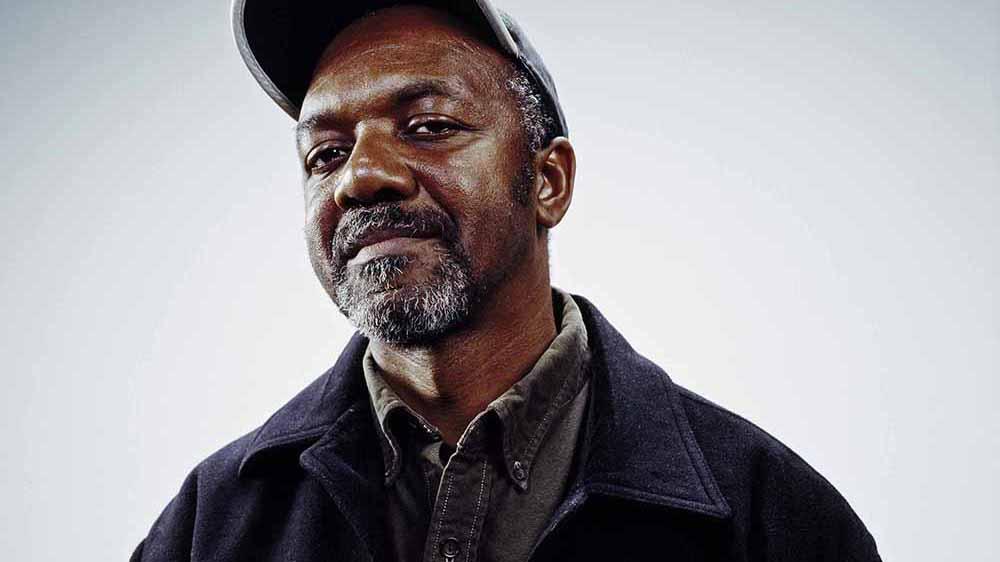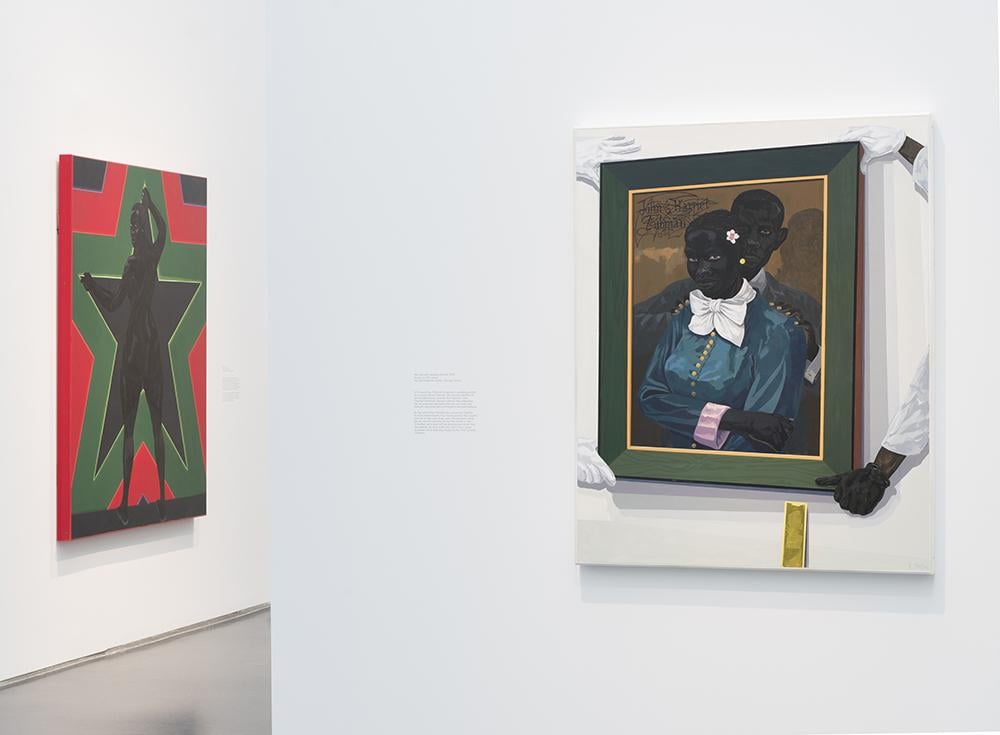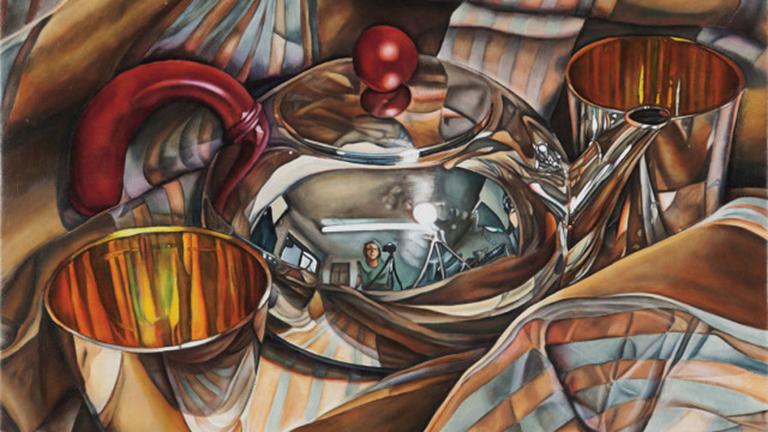Kerry James Marshall Photo Cameron Wittig Courtesy Walker Art Center Minneapolis
The video cannot be displayed.
Chicago-based artist Kerry James Marshall has long been the focus of international attention.
From his art studio in Bronzeville, he makes paintings sought after by museums and galleries effectually the world. The images are often meditations on American history.
His works are in the collections of the Smithsonian, the National Gallery and the Fine art Institute.
At present the artist is being recognized with a career retrospective at the Museum of Contemporary Art, called "Kerry James Marshall: Mastry." Nosotros caught upwards with him at the opening.
TRANSCRIPT
 Kerry James Marshall (Cameron Wittig, Walker Art Eye, Minneapolis)
Kerry James Marshall (Cameron Wittig, Walker Art Eye, Minneapolis)
Phil Ponce: The paintings of Kerry James Marshall fill the fourth floor galleries at the MCA Chicago. Large canvases present modern themes painted in classical art traditions. His dissections of matters of race can be provocative: The figures often gaze straight at the viewer. Their pare tones are strikingly blackness. The pictures conjure a foreign magic.
Nosotros asked the artist what information technology feels like to see his life's work assembled.
Kerry James Marshall: It does make yous a little airheaded sometimes, wandering around through the parts of your past, things you've done a long fourth dimension ago. I have some things that I haven't seen in 25 years in hither, and so it's always really a pleasure to see things that you tin still feel comfortable with and confident about and that you really made some things even when y'all were younger that you lot tin be proud of.
Ponce: Born in Birmingham, Alabama, and raised in the Watts neighborhood of Los Angeles, Marshall at present lives and works in Bronzeville, where "Chicago Tonight" visited him in 2009. Some of what he was working on then is now in the retrospective at the MCA – including an ongoing comic book project, "Rythm Mastr," in which African statues come to life to help a neglected Chicago neighborhood.
Nearby are intense reflections on the Civil Rights era and even kitsch-inspired works.
"Past Times," 1997. (Courtesy of the MCA)
Madeleine Grynsztejn, director of the MCA: Kerry James Marshall is a master of painting. He has taken it upon himself to become a main of every genre of painting, from landscape paintings to still lifes (similar you see backside me), to history paintings. You volition encounter in this exhibition and the unabridged trajectory of Kerry's career, a focus on the black effigy, very black effigy. Kerry has devoted himself, a kind of ane-homo-band in the commitment to entering the blackness figure into the history of art.
When y'all go to near museums, most encyclopedic museums, most museums of modern art, yous actually don't encounter a lot of black people on the walls, and Kerry is single-handedly committed to sort of course-correcting that absence.
Ponce: We asked Marshall about the emphatic black tones he uses for the figures in his paintings and drawings.
"Better Homes, Improve Gardens," 1994 (Courtesy of the MCA)
Marshall: When I get-go arrived at this black figure as the field of study, I started using information technology as a rhetorical device. And and so if you think about the means which nosotros use language – and movie-making is a language system likewise – that rhetorically when we talk most black or we talk about blackness people or talk nearly white people, we're not describing the nuances that might be nowadays within a collection of people or a population. And the reason you exercise that is because at the rhetorical extremes, this is where y'all gather the almost ability and where you have the most impact. And and so if I'm going to be addressing the bailiwick of blackness and representation, and its either presence or absenteeism within the historical narrative of painting, what I want to do is gather the most power and to exist able to deliver it with the most intensity. So that'southward why I started using the black as a principal color.
I also wanted to be unequivocal that when you see a effigy in a painting, that you immediately identify that figure as black, and once you identify that figure equally blackness then you no longer have to recollect about that, now you can go on to consider all of the other things about the context in which you lot run across the figure.
"Ameliorate Homes, Better Gardens," 1994 (Courtesy of the MCA)
Within that blackness in that location are levels of complexity in the blackness, they are non just flat black. I hateful they may take started out that fashion, started out every bit silhouettes and shadows but over fourth dimension what I think I've been able to demonstrate is that, even within the farthermost of that black, y'all can involve levels of complexity that crave people to look more than closely at the thing and non simply assume when they meet it that at that place'south even more absence inside the black subject, as it's represented.
Ponce: We likewise asked him near the sometimes monumental calibration of his works.
Marshall: Calibration matters. When I make a moving picture like this, I'm interested in calling attention to the picture and the bailiwick inside information technology considering I call back the field of study is that important. Information technology's of import enough to notice, and I don't desire to make pictures that you can easily overlook or hands laissez passer by without at least taking business relationship of information technology.
Ponce: Among his recent paintings is a wedding ceremony portrait of Harriet Tubman. He gave his reaction to the news that she will be featured on the $20 bill.
Marshall: It's an interesting development. What I'chiliad glad almost is that they finally decided non to take Hamilton off the x, which didn't brand any sense to me, and to supplant Andrew Jackson, which made a lot more than sense. And that Harriet Tubman is the person they chose is pretty exciting I think.
 On the right, "Wedding Portrait of John & Harriet Tubman" (Courtesy of the MCA)
On the right, "Wedding Portrait of John & Harriet Tubman" (Courtesy of the MCA)
Grynsztejn: This is such a great moment for this artist, Kerry James Marshall, only it'southward also a great moment for the city of Chicago because it has in its ranks a fantastic, fantastic artist who has international acclaim. And an indication of that is after we close this exhibition hither in September, information technology travels New York Metropolis'southward Metropolitan Museum and after that to Los Angeles's Museum of Contemporary Art. So this is the moment to come to the Museum of Contemporary Art and see a living, neat artist, 1 of the greatest living American artists anywhere, who happens to be from Chicago. Information technology's one of the moments to come here, come across all of his work, and as well see how Chicago itself informs his practice.
Ponce: Marshall has a clear view of his artistic practice.
Marshall: I run into everything through the filter of possibility, and the possibilities that noesis emboldens you to be engaged with. That's how I encounter the world.
The "Kerry James Marshall: Mastry" exhibition recently opened at the Museum of Gimmicky Fine art Chicago and runs through Sept. 25.
Related stories from "Chicago Tonight"
 Art in Motion Showcases Talents, Progress of RIC Patients
Art in Motion Showcases Talents, Progress of RIC Patients
May 2: The 14th annual Rehabilitation Institute of Chicago fundraiser features artwork by 23 of their patients, including art past two rima oris painters who will show off their skills during Th'south opening reception.
 Virtuoso Photo-Realist Painter Returns to Chicago
Virtuoso Photo-Realist Painter Returns to Chicago
Apr 29: Meet the onetime stay-calm mom who painted everyday kitchen objects before emerging as a sought-afterwards creative person.
 MCA Appoints New Associate Curator Jose Esparza Chong Cuy
MCA Appoints New Associate Curator Jose Esparza Chong Cuy
April viii: Writers and curator Jose Esparza Chong Cuy, who was previously associate curator at the Museo Jumex in Mexico City, replaces Julie Rodrigues Widholm.
 Kerry James Marshall
Kerry James Marshall
October six, 2009: Praised for his paintings, a renowned Chicago artist goes dorsum to the drawing lath to create a comic strip.
Source: https://news.wttw.com/2016/05/03/master-painting-brings-art-bronzeville-world
0 Response to "Kerry James Marshall Photo Cameron Wittig Courtesy Walker Art Center Minneapolis"
Post a Comment